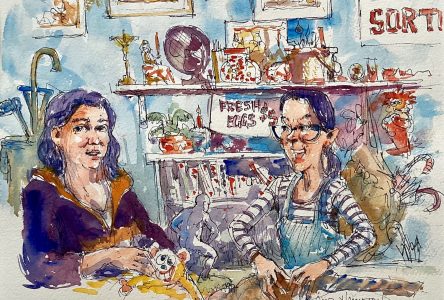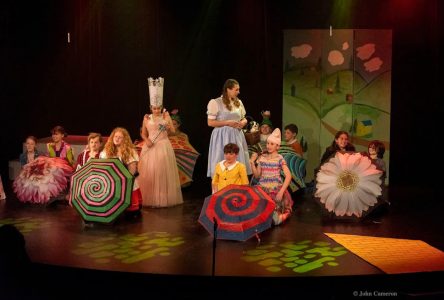Art is a matter of seeing, which is apparent in the paintings of Frelighsburg-based artist Susan Gerson Galusha. While bright colours meet us at eye-level on her canvases, emotion is the point of departure for her work, which includes oil, watercolour, and encaustics.
At first glance, many of her stilllife paintings seem to show a tea party, with a teacup and fruit resting peacefully beside a vase of flowers. However, when taking time to examine the scene, we begin to notice something is missing; there is a teapot and enough food for two people, yet only one teacup is set out. A woman sips her cup of tea alone, looking wistfully at the empty seat beside her. This lack expresses a certain loneliness and nostalgic longing for the guests who are not present, which is felt throughout her work.
“Teapots mean to me old friends getting together, having a cup of tea,” Sue explains. “And [my paintings] are thinking of the people who aren’t there to share tea with you, but the table is set for them anyway.”
Separating the art from the artist is impossible with Sue’s work, as her emotions are their driving force. The emotion that lurks behind her deceptively simple paintings help to distinguish her scenes from other still-life works that aim to present a realistic image of the world.
“I never want to be like a photograph,” she explains. “My work is expressionistic; it’s coming from my head or memory or something right in front of me. But there’s a looseness to it; an energy in the strokes, the lines.”
Emotion aside, everything we see on the canvases that line her Frelighsburg gallery derives from six colours, the same she has been using for 50 years. Instead of buying a set of paints with multiple different shades, Sue is free to create whichever ones she needs by blending her six together: cadmium yellow light, yellow ochre, cadmium red light, alizarin crimson, cerulean blue, and prussian blue all come together on her palette to form bright new worlds that she commands.
While more time consuming, when mixing your own colours, “You have harmony, which is very important,” she explains. “The colours will sing.”
In this way, her work involves a double creative process; the first act of creating colour, and the second act of bringing that colour to life on canvas. These shades jump out to the viewer in her paintings depicting both domestic spheres and landscapes that explore her native Quebec and her stays across the United States, particularly Utah.
When not working on something new, Sue has been an art teacher for 29 years, where she instills her students with the importance of honing one’s skills. Nobody can become a famous artist overnight, but understanding the ways of seeing and sharpening one’s artistic gaze will get you farther than following any art trends can. As she demonstrates with her expressionist paintings, seeing doesn’t always mean literally what is in front of you. Working from emotion and memory, she paints Quebec when she is in Utah, and paints Utah when she is in Quebec. She recalls painful or lonesome times onto the canvas in the form of brilliant colours and flowers. Being able to see in this way can bring us closer to her vision, as we drink in her feeling-infused paintings as if we were there alongside her, sipping a cup of tea.
Sue currently has two paintings on display at the Bruck Museum in Cowansville as part of the Tissu et Fibre exhibition. To see more of her work, her permanent studio and gallery are located at 23 Chemin de Pommes, Frelighsburg, QC.

